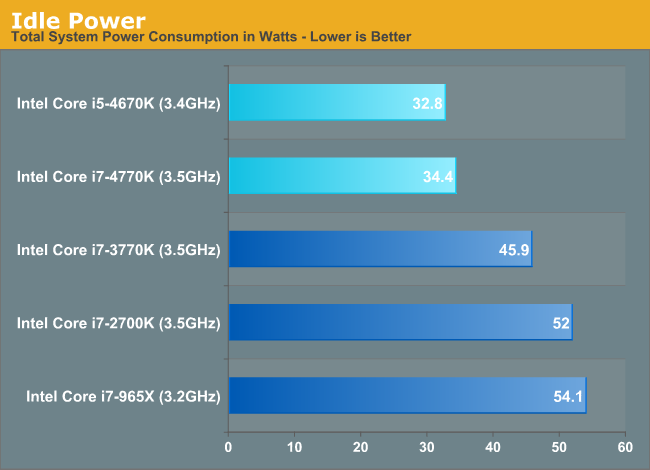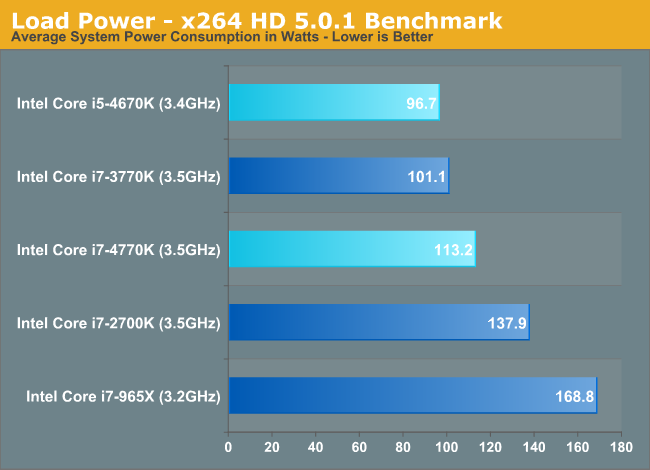The Haswell Review: Intel Core i7-4770K & i5-4670K Tested
by Anand Lal Shimpi on June 1, 2013 10:00 AM ESTPower Improvements
Although Haswell’s platform power is expected to drop considerably in mobile, particularly with Haswell U and Y SKUs (Ultrabooks and ultrathins/tablets), there are benefits to desktop Haswell parts as well.
There’s more fine grained power gating, lower chipset power and the CPU cores can transition between power states about 25% quicker than in Ivy Bridge - allowing the power control unit to be more aggressive in selecting lower power modes. We’ve also seen considerable improvements on lowering platform power consumption at the motherboard level as well. Using ASUS’ Z77 Deluxe and Z87 Deluxe motherboards for the Haswell, Ivy and Sandy Bridge CPUs, I measured significant improvements in idle power consumption:

These savings are beyond what I’d expect from Haswell alone. Intel isn’t the only one looking to make things as best as can be in the absence of any low hanging fruit. The motherboard makers are aggressively polishing their designs in order to grow their marketshare in a very difficult environment.
Under load, there’s no escaping the fact that Haswell can burn more power in pursuit of higher performance:

Here I’m showing an 11.8% increase in power consumption, and in this particular test the Core i7-4770K is 13% faster than the i7-3770K. Power consumption goes up, but so does performance per watt.
The other big part of the Haswell power story is what Intel is calling FIVR: Haswell’s Fully Integrated Voltage Regulator. Through a combination of on-die and on-package circuitry (mostly inductors on-package), Haswell assumes responsibility of distributing voltages to individual blocks and controllers (e.g. PCIe controller, memory controller, processor graphics, etc...). With FIVR, it’s easy to implement tons of voltage rails - which is why Intel doubled the number of internal voltage rails. With more independent voltage rails, there’s more fine grained control over the power delivered to various blocks of Haswell.
Thanks to a relatively high input voltage (on the order of 1.8V), it’s possible to generate quite a bit of current on-package and efficiently distribute power to all areas of the chip. Voltage ramps are 5 - 10x quicker with FIVR than with a traditional on-board voltage regulator implementation.
In order to ensure broad compatibility with memory types, there’s a second input voltage for DRAM as well.
FIVR also comes with a reduction in board area and component cost. I don’t suppose this is going to be a huge deal for desktops (admittedly the space and cost savings are basically non-existent), but it’ll mean a lot for mobile.
No S0ix for Desktop
You’ll notice that I didn’t mention any of the aggressive platform power optimizations in my sections on Haswell power management, that’s because they pretty much don’t apply here. The new active idle (S0ix) states are not supported by any of the desktop SKUs. It’s only the forthcoming Y and U series parts that support S0ix.










210 Comments
View All Comments
Ninokuni - Saturday, June 1, 2013 - link
"The new active idle (S0ix) states are not supported by any of the desktop SKUs"Does this mean the whole PSU haswell compatability issue is now irrelevant?
jhoff80 - Saturday, June 1, 2013 - link
I believe that PSU issue was in relation to the C6 and C7 states, not S0ix.smilingcrow - Saturday, June 1, 2013 - link
Correct as desktop PSUs are used with desktop CPUs. :)Egg - Saturday, June 1, 2013 - link
To reiterate owikh84, there appears to be a serious typo in the title - it should be 4670k, not what appears to be a nonexistent 4560k part.RaistlinZ - Saturday, June 1, 2013 - link
This review was a bit more positive than the one at Guru3d. Their numbers show the performance difference being almost nothing. Guess my i7-930 @4Ghz will dredge on for another generation.chizow - Saturday, June 1, 2013 - link
I'd consider it but the IPC gains alone since Nehalem make the upgrade worthwhile, and the rest of the X58 specs are already sagging badly. It still does OK with PCIE bandwidth due to the 40 total PCIE 2.0 lanes, but 20 PCIE 3.0 lanes is equivalent with PCIE 3.0 cards. The main benefit however is running SATA 6G for my SSDs and gaining some USB 3.0 ports for enclosures, etc. They have been bottlenecked for too long on SATA 3G and USB 2.0.I would consider waiting for IVB-E or Haswell-E but Intel always drags their feet and ultimately, these solutions still end up feeling like a half step back from the leading edge mainstream performance parts.
zanon - Saturday, June 1, 2013 - link
Intel's artificial segmentation of some features are more irritating then others, but not including VT-d everywhere really, really sucks. An IOMMU isn't just helpful for virtualization (and virtualization isn't just a "business" feature either), it's critical from a security standpoint if an OS is to prevent DMA attacks via connected devices (and just helping increase stability also). It should be standard, not a segmentation feature.klmccaughey - Monday, June 3, 2013 - link
Yea, I just don't get why they dropped VT-d. Really silly. A lot of power users on the desktop use virtualisation.Chriz - Saturday, June 1, 2013 - link
I'm curious about something. If you say Intel got rid of legacy PCI support in the 8 series chipsets, why am I still seeing PCI slots on these new motherboards being released? Are they using third party controllers for PCI?CajunArson - Saturday, June 1, 2013 - link
"Are they using third party controllers for PCI?"Yes.